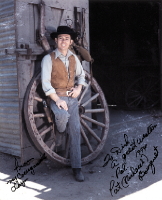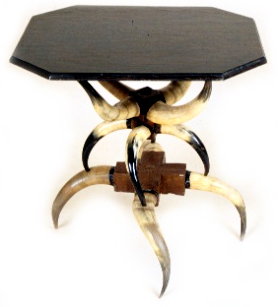Western Decor Still Popular
By Patrick Bousquet, 1992
CLICK AN IMAGE TO ENLARGE
In this day of high technology, I am still amazed how many people still enjoy decorating their home with Western flavor. This can consist of Cowboy, Indian, Pioneer, Mining, even Movie Cowboy items.
As a small boy growing up in a small Masschusetts town, I always had a love of the West or anything that had to do with the West. My first impression came with the cowboy movies and even though I enjoyed them and still do today, it was the props that I took note of quite often. The guns that were used, branding irons, Navajo rugs hanging on the walls or draped over chairs. Some of the pictures that hung on the walls were actual Western Art. Many times you could see Mission style furniture, leaded glass bookcases and Steer Horn furniture.
Many of the props used by the studios have found their way into homes or collections today, due to the studios having done away with many of their older props. I have a sign that was used at Republic Studios in one of their western film's. It was given to me by the late "Black" Jack O'Shea, who worked in a number of Roy Rogers' films as well as other Republic westerns. It's an auction sign for mining equipment. Another prop item is a wanted poster with Gary Merrell's photo on it from Universal Studios. I also have a badge that was worn by the late Nick Adams of the Rebel series while doing the series.
The Potlatch Corporation of Cloquet, Minnesota, puts out a calender every year on their Mountie Matte paper. It always has a Royal Canadian Mountie scene done by the well-known artist, Arnold Frieberg. I have about fifteen year's worth of these calender prints. They look quite nice in frames.
Something that really adds flavor to Western Decorating is to find some history associated with an item. I will share three such item's with you -- badges. The first one is a small star badge with the number 1 on it with the words "Fargo Opera House." Through research with the Historical Society in Bismark, North Dakota and Fargo newspapers, I found out the following:
One of the people that answered the newspaper ad played in the band at the opera house and he remembered that the ushers wore the badge. He also provided me with some history of the opera house.
My next badge is a fire-buff badge from San Francisco, California. The shape resembles the front of a fireman's helmet. It is number 118 and has the words "Admit bearer within fire line to June 30, 1915, Board of Fire Commissioner, San Francisco." In the center is a photo of David Scannell. David Scannell was chief of the San Francisco Fire Department from 1871 to 1892. His photo was used to honor him in 1915.
My third badge is a small, fancy shield type with the words "G.B. Vallandigham, Editor of North Dakota Patriot, Co. E. 125th Ohio Vol. Infty. War of 61-65. Mr. Vallandiham enlisted in the Ohio Volunteer Infantry in 1862 and was discharged from service on July 21, 1865. He was involved in six Civil War battles and several skirmishes. After the war he returned home, attended college, returned to newspapering in New York and wound up in newspapering in Valley City, North Dakota.
These badges, framed with their letter of history, make fine home decorations.
For you older western buffs, do you remember the covered wagon or horse clocks? How about a horseshoe with cactus on either side and the clock in the center of the horseshoe? These were made of pot metal and bronzed over and they look great on a mantel or shelf. They were electric and nowadays most of them do not work, but they look fine with a quartz movement in them.
Back in 1957, there was a furniture company in Austin, Texas, called Economy Furniture. They built three kinds of furniture: Western Provincial, Smithtown Maple, and Bilt-Rite.
The Western Provincial furniture was quite unique. All of it had a western motif; sofas and chairs, coffee table and end tables with wagon wheel sides. There was also children's furniture, bedroom furniture, and sofa beds. The covering was a heavy fabric-backed plastic that looked like leather. In 1958, a sleeper sofa with wagon wheel sides and a horse-head design on the cushion backs cost $195 and a chair with a cushion was $75.00. Economy Furniture is still in business today.
On a recent trip to Austin, Texas, I found a telephone number and address for the company and drove by to see if they still made the Wagon Wheel line. The words "Western Provincial" were still on the side of the building. Later, I called and was put in touch with the sales manager, Mr. Charlie Bowers.
Mr. Bowers informed me that the wagon wheel line had been dropped for a number of years but had been re-introduced in January of 1992. It is not available in California at this time. McMahan's furniture in California carry the Economy line of furniture but have yet decided to carry the Wagon Wheel line of furniture. Also, I cannot even order it because Economy only sells to retailers. Hopefully, that will change. Anyone seeking more information should contact Mr. Charlie Bowers, Economy Furniture Industries, P.O. Box 9788, Austin, Texas 78766-9788. Their telephone number is (512) 836-0111.
As I was putting this story together, I visited a furniture store that features western items. It was here that I discovered that a young man is now reproducing early 1920s California Western Furniture. Mostly though, he custom-builds to the customer's request, but does have a few stock items to show to people. More information may be obtained by writing Brand Craft Frame Design, 85 Apricot Street, Oak View, California 93022-9455. The telephone is (805) 649-1660.
There was another company that made wagon wheel hub furniture. It was The Wagon Wheel Ranch in El Rito, New Mexico. They produced hub lamps with an etched chimney at a cost of $17.95 that included shipping and handling. Model #3 hub lamp had a tapered lamp shade and cost $25.95. Each hub had three famous brands burned into the wood. There was a wagon wheel with suspended hub lamps and there was a wagon wheel coffee table.
Last year I found a pair of the wagon wheel hub lamps at a swap meet. I had to rewire them and buy new shades. I hope to find some western-style shades for them some day.
 Railroad items are quite popular such as caboose stoves, conductor lanterns, tools, station cabinets, and signs. Several years ago, I purchased a pair of caboose lanterns at a swap meet. They had been used on a patio, one on each side of the patio door. One lens had been removed from each of the lanterns and then hung from the handle over a light bulb.
Railroad items are quite popular such as caboose stoves, conductor lanterns, tools, station cabinets, and signs. Several years ago, I purchased a pair of caboose lanterns at a swap meet. They had been used on a patio, one on each side of the patio door. One lens had been removed from each of the lanterns and then hung from the handle over a light bulb.
By now, you who may be new to western decor may be asking, are these kinds of items still found in today's collecting world? The answer is yes. Two years ago, I was at a garage sale and purchased two hand-made wrought iron hanging lamps. The woman that owned them told me that her father had made them years ago and she inherited them but never had been able to use them in her home. Her father had done much of the wrought iron work at the Mission Inn in Riverside, California. A few months ago, I found a hand-made covered wagon at a swap meet with a light inside it. I paid five dollars for it.
At one time I owned a buckboard and a springwagon and had them in my backyard. Finding Western Decor items takes a little effort but it can be done. Even a next door neighbor may have something in their garage as I found out just a year ago.
Good hunting and have fun.
Used with author's permission.
